Highbush cranberries are a delicious, tart wild fruit that taste a bit like cranberries. In this post I tell you everything you need to know about harvesting and cooking with these.
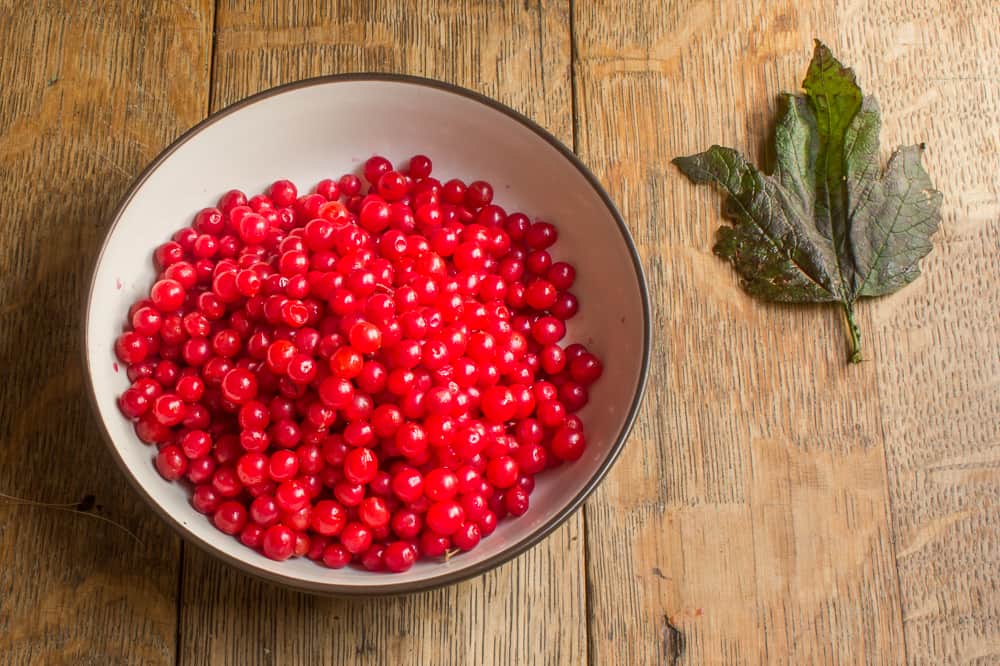
Originally I thought Highbush cranberries were the most disgusting, stinking, fetid-scented foraged fruit I've ever tried. At least they were until I found out the truth about them. I mean what would you ever want to make with a fruit that tastes like the essence of wet dog, with a lingering bitter aftertaste strong enough to ruin your next meal?
Below: unripe highbush cranberries start out yellow, eventually turning red.
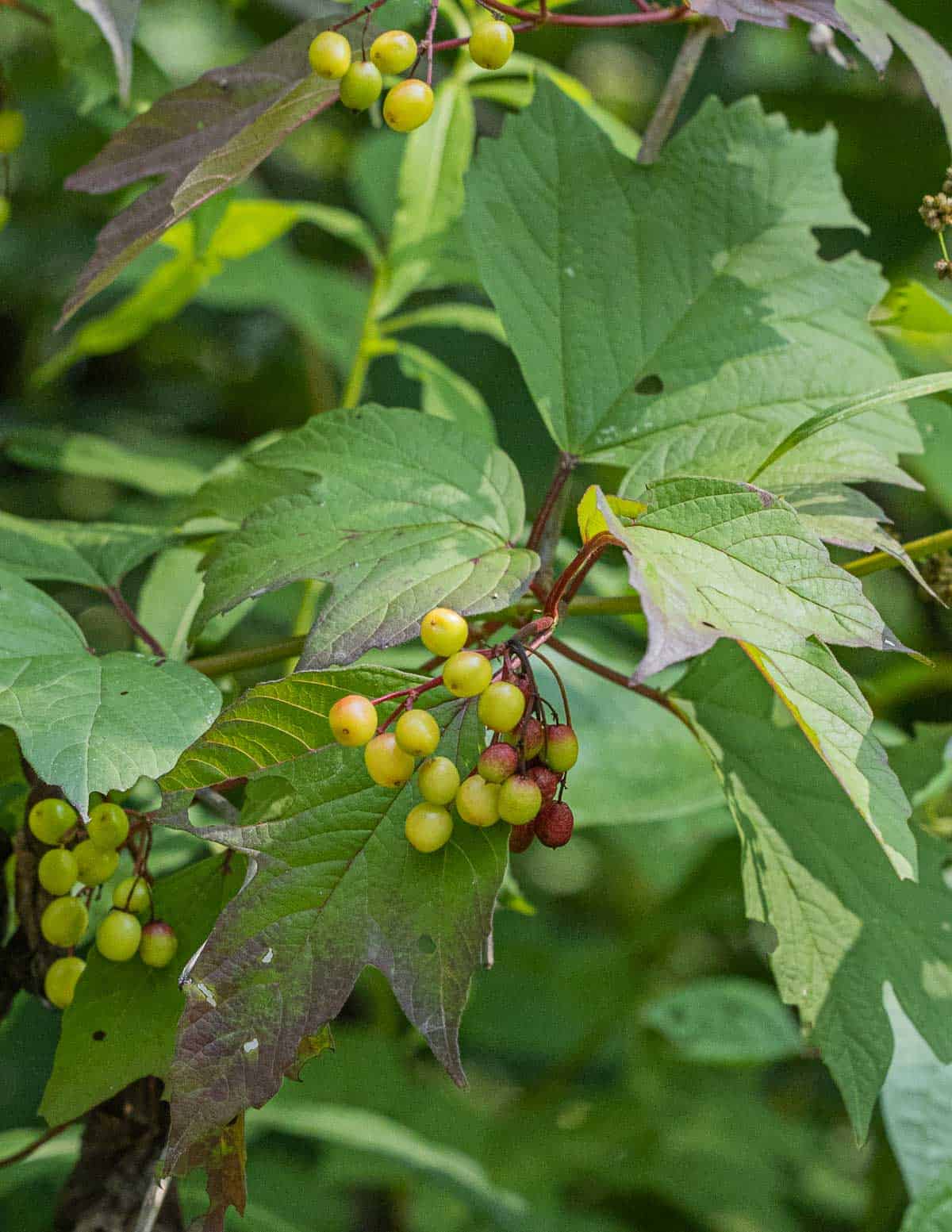
Two Types, Two Flavors
There's actually more than two, types, but for the purpose of this post, I'm only discussing the two I see the most: Viburnum opulus and Viburnum trilobum. There's other edible viburnums too, like nannyberries (Viburnum lentago).
Highbush cranberries are confusing, first, as they aren't really a cranberry at all, as true cranberries are in the blueberry family or Vaccinium which makes small low-growing bushy plants, while highbush cranberry is a small shrubby tree, more similar to something like Armelenchier, or serviceberries.
The shrubs are attractive, and good for birds as they fruit many berries dependably each season. I've even harvested berries as late as January, since they'll dependably stay on the shrub, sometimes months after the growing season has ended.
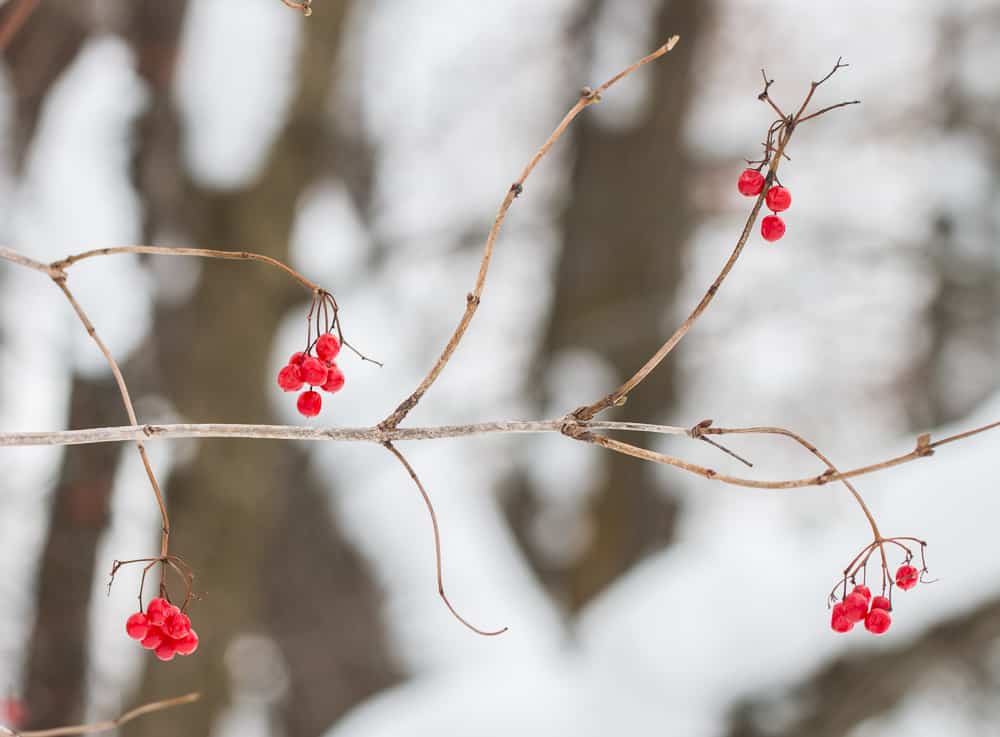
Guelder rose vs Highbush Cranberry
So why doesn't anyone pick them? Why the conflicting accounts of widely variable flavors? In short, because there's more than one type, and telling them apart with the naked eye is difficult unless you know exactly what you're looking for.
The tasty and native North American highbush cranberry is Viburnum trilobum, the European / Asiatic imposter is Viburnum opulus, commonly called the "Guelder Rose". How do you tell them apart you ask? Easy. taste one. (The other way to tell them apart that's been explained to me is that American highbush cranberry has convex, or rounded glands near the base of the leaf, where European ones will have flat or sunken ones).
Some like the bitter fruit
Over the years now I've gotten lots of comments from people with Eastern European heritage about these. One friend of mine from Russia insists that the European species tastes fine and palatable macerated in vodka. I disagree.
For reference, I've been told that the Russian name for highbush cranberries is "Kalina" whereas typical cranberries are "Klyukva". The same person also mentioned that the Kalina were made into a pie or strudel in her family.
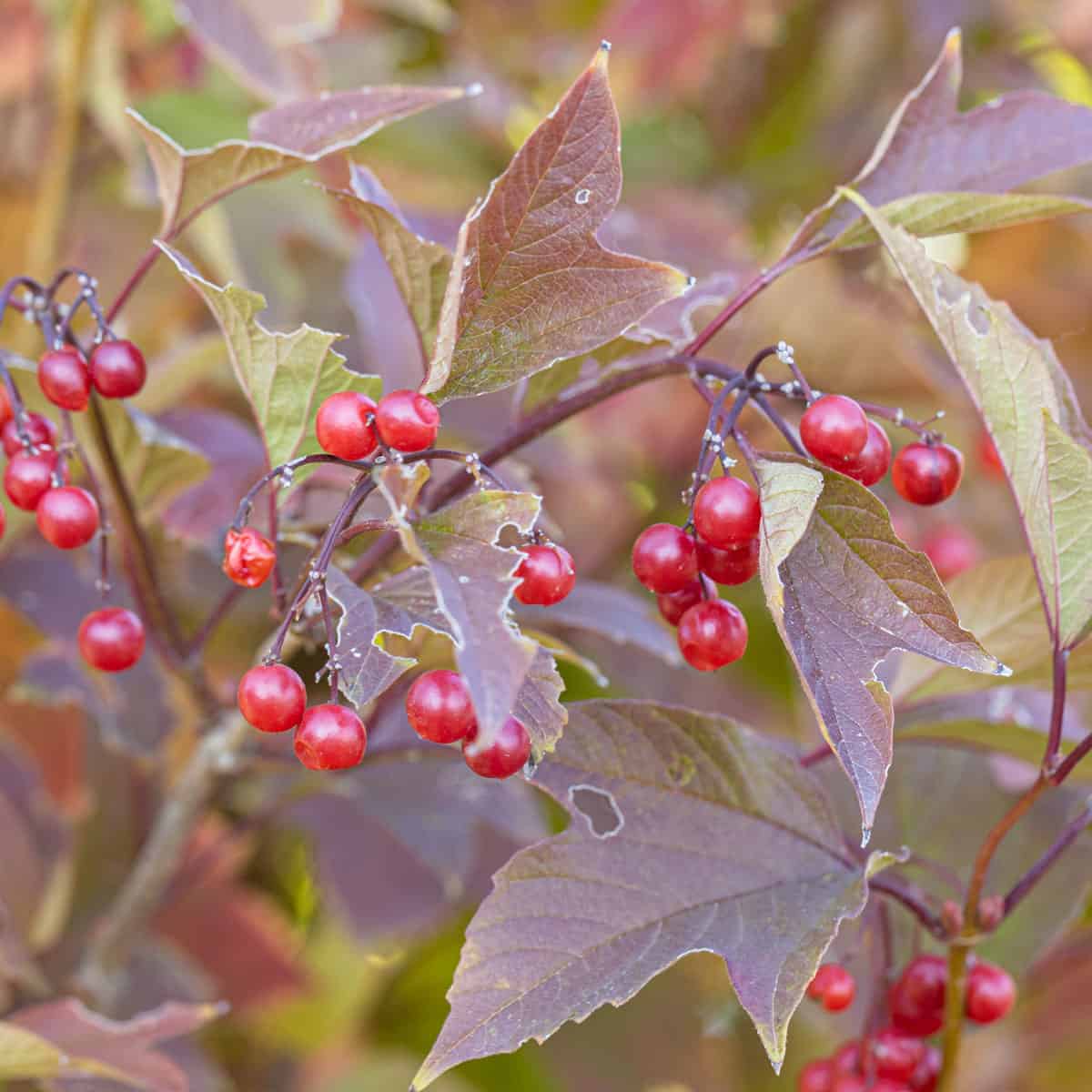
Just because you find a couple trees that are next to each other, and one tastes good, don't expect all of them to taste the same. I regularly find native Highbush cranberries hidden here and there among European ones which seem more common in my area. Be warned, just a few berries from the European shrub can ruin whatever you're making.
True American highbush cranberries, and the related, superior cultivars I've tasted will all have a pleasant, tangy taste, not bitter, or stinky. American highbush cranberries may have a gentle hint of the funk of the European, but it's not offensive, and the cultivars I've tasted from Sam Thayer's orchard (huge in comparison to others, nearly the size of grapes!) had no hint of it at all.
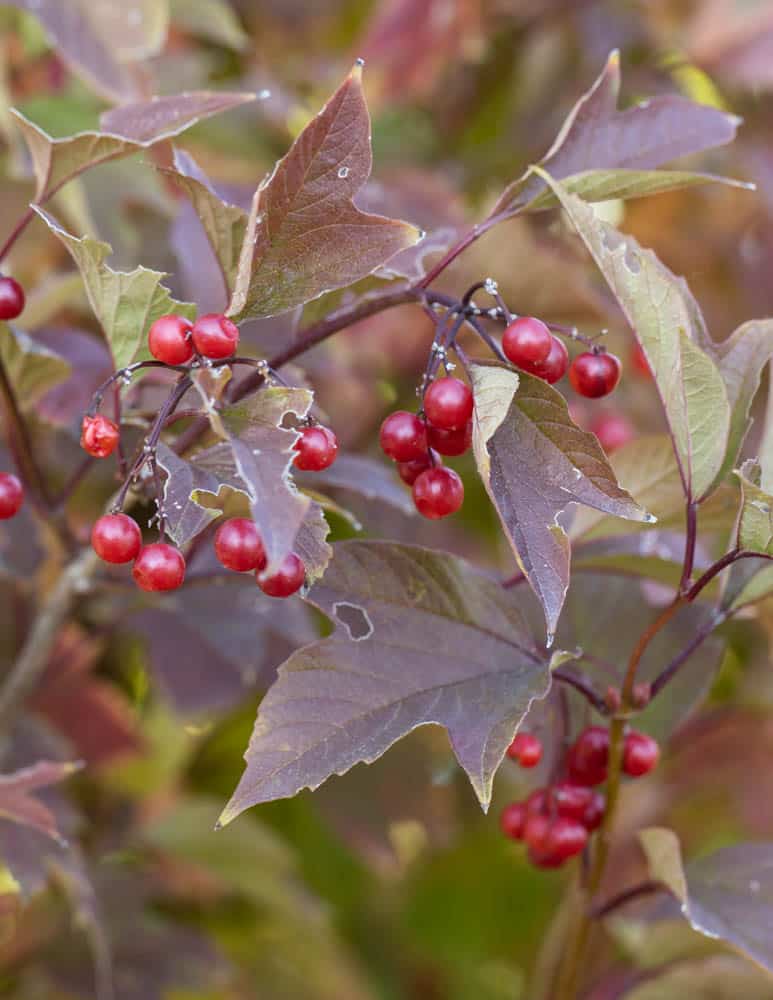
ID tips for getting the right ones
In his first book The Forager's Harvest Sam Thayer describes a few extra botanical characteristics you can use to separate the two species. V. trilobum also has larger leaves with less teeth, and thicker, lighter colored twigs.
Plant Your Own, But Don't Necessarily Trust a Nursery
Highbush cranberries are a great addition to an edible yard or food forest. There's been growing interest in planting native highbush cranberries over the years, and I know Sam Thayer, who I learned about these from in person and through his books, occasionally sells native highbush cranberry transplants.
Unfortunately, sellers and nurseries in the Midwest have been known to mid-identify the bitter, wet-dog tasting European imposters for our Native highbush cranberries, labeling them as such, and further confusing people about the edibility of the plant in general. So, do your research before buying saplings and planting.
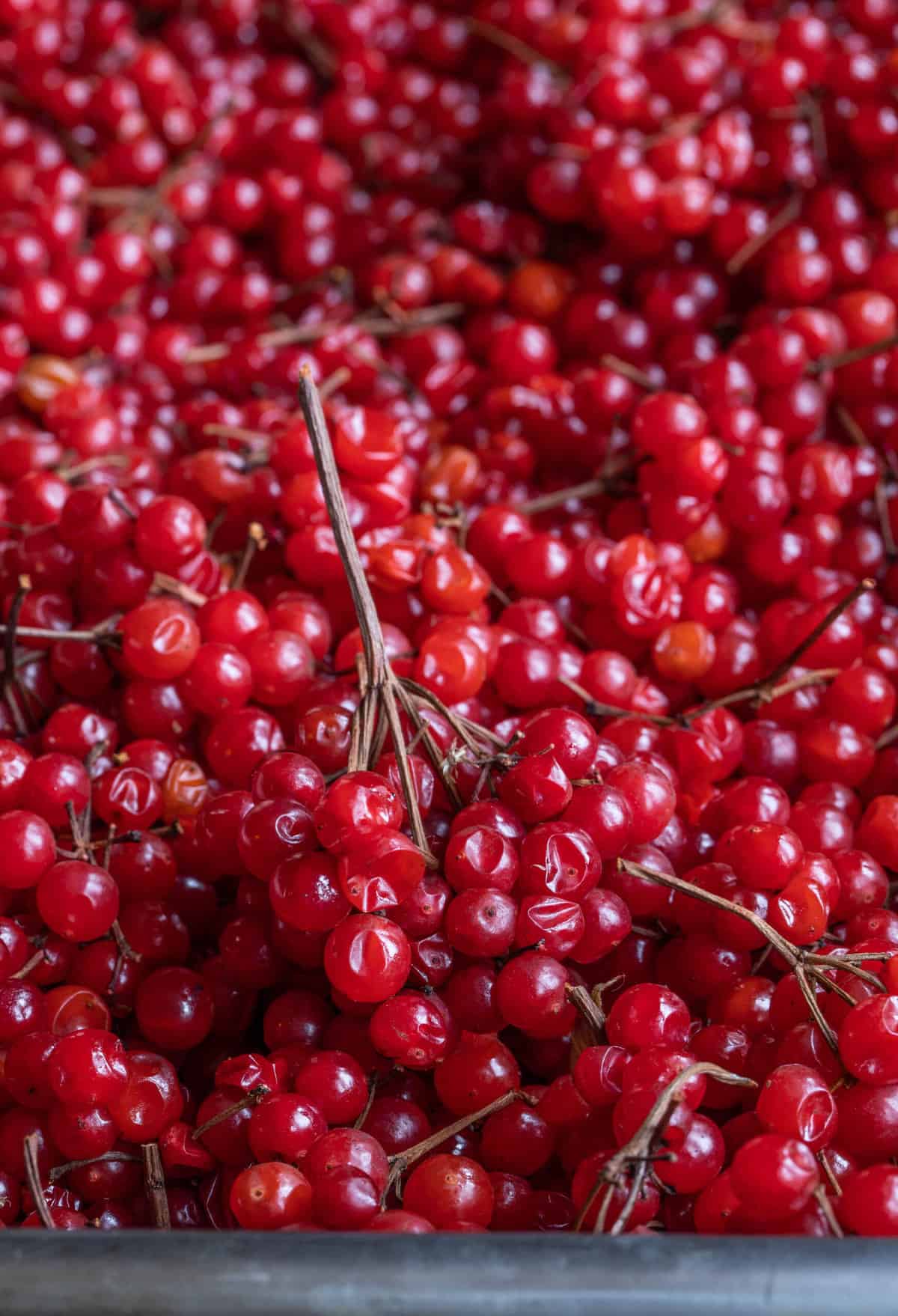
Harvesting
Gather the berries in the fall, or, if you have access to some, early winter. Make sure to taste berries from different trees if it's your first time. If it's been rainy and windy, or the berries are in a sandy location, I may rinse them before processing. Often the berries are clean and don't need a rinse though.
Do you have to remove the stems?
Not necessarily, and I know plenty of people that don't. If you have a large harvest, if may be easier to just pick the clusters, stem and all off the shrubs. If you leave the stems on, you may want to simply mash them without using a handblender as I recommend in the juicing method below.
Cooking / Juicing
You're not going to make compote out of these. Like other Viburnaceae, highbush cranberries have a single, flat seed, and they need to be removed before you can work with the product.
You can extract the liquid by juicing, but don't even think about putting them into a juicer. Just like aronia berries, and nannyberries, these will need to be cooked (in this case mashed) with a little water and strained. See the recipe at the bottom of the page for an idea of what to do.
Avoiding bitter juice
Unlike aronia berries, if you boil highbush cranberries with water to extract a juice, it will be bitter. Small batches I've done were less bitter, but especially if you have a large batch of these, you will definitely want to do a cold-extraction. The seed coming into contact with heat seems to be the culprit. You may get slightly less juice using a cold method, but the flavor will be worth it. Trust me.
Preservation
Highbush cranberry juice can be frozen. Jams, jellies, and sauces made from it can be canned and cooked in a water bath.
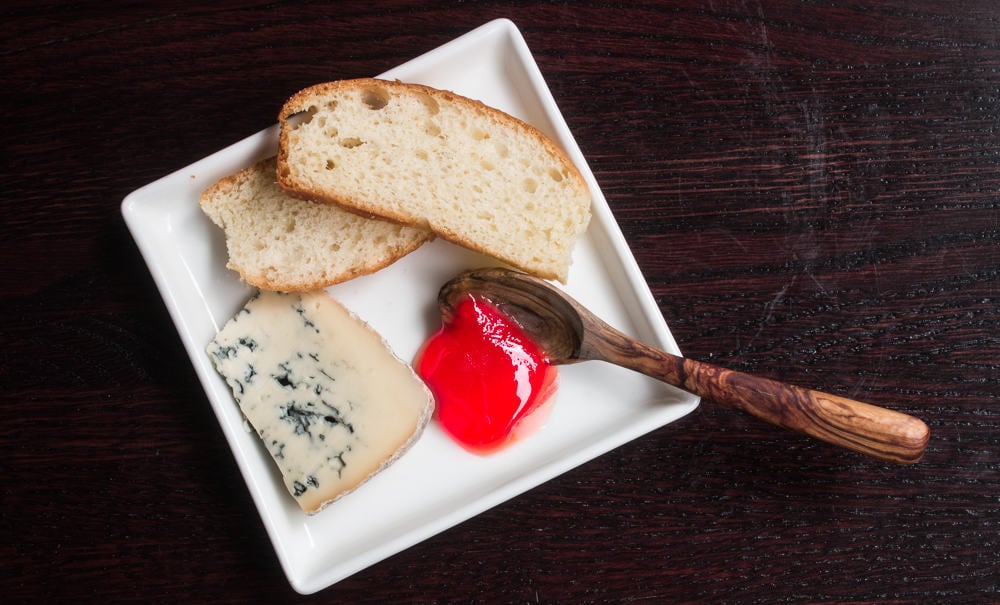
As far as extracting the juice to cook with, here's two ways I've done it. Sam Thayer reccomends a cold extraction, since some of the funkiness of the berries, even tasty species, can come out if the seeds are simmered with the juice.
The hot method is slightly easier than the cold, but they've both made fine products. The slight funk pairs very well with stinky blue cheeses.
Recipes
- Highbush Cranberry Tkemali
- Highbush Cranberry Vodka
- Highbush Cranberry Hot Sauce
- Highbush Cranberry Ginger Jelly
- Highbush Cranberry Sauce
Highbush Cranberry Juice (Cold Extraction)
Ingredients
- Highbush cranberries rinsed and cleaned as needed
- Water
Instructions
- Mash the highbush cranberries, then combine with water until it barely comes up to the top of the berries.
- Pulse the berries until they're broken up a bit with a handblender (optional) agitating and whisking well to get as much of their essence into the water as possible, then strain. This will make a thicker pulpy coulis/loose puree.
- For a clear juice, just strain them without using a handblender.
Notes
- Combine the highbush cranberries with water until it barely comes up to the top of the berries, in the kitchen we used to describe this as looking like hippopotamuses floating in water.
- Bring the mixture to a simmer, then turn the heat down to low, mash the berries gently, not vigorously, since extra agitation and contact with the seed will lend bitter notes to your juice.
- Cover and cook for 20 minutes on the lowest heat possible, then strain, chill and refriegerate or freeze until needed. Raw juice will last for a few days in the fridge.

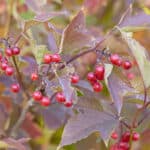
Bonnie M Hays
Glad I found your site as I finally picked some berries from the shrubs I got from our County conservation sale. They only sell native plants but I cant find the variety I bought. Not too terrible a taste. My question is does the berry ever spoil or turn rancid while on the bush? I was surprised you can use them so late into winter. I was only saving those that were still round and intact and not sunken or broken but from your picture, sunken ones are OK?. Thanks!
Alan Bergo
HI Bonnie, no, as long as the fruit is a nice red color, and has a nice tart taste when you eat one, they're fine. They make be slightly drier, so they could take more water during the cold-juicing process.
Alex Skibinsky
We were lucky to live where there was a abundance of all kinds of wild berries that were at times mixed with the cranberries and made into jams and jellies. This was in central eastern Saskatchewan. We always picked our own berries but the Native Cree Nation would pick them also and sell them to the merchants in town.
Alan Bergo
Thanks for sharing Alex.
Alex Skibinsky
Remembering my mother cooking or blanching high bush cranberries and then putting them through a large cone sieve with a wood pestle. I am sure she may have added other ingredients such as sugar, gelatin etc. It was then canned for the winter months. Very tasty.
Pierre Blin
Hello. When you say don't even think of using a juicer, does that also mean a steam juicer?
Sandra McHarg
I've collected some seeds from a yellow fruited viburnum, which I'm considering trying to grow. As far as I can tell it's Viburnum opulus "Xanthocarpum". Am wondering if you've had any experience with that variety? I believe it's one of the European "Guelder Rose" types.
Alan Bergo
I don't bother with the European varieties. They smell awful and taste bitter.
Corinna Atterton
You say east, taste one.. And you describe the yucky, bitter, wet dog taste of the European variety. But, could you please describe the taste a newbie can expect from the good ones who've never tasted either berry before? My neighbor has some bushes and I plucked a berry and tasted it. It was sour but not disgusting... Is that what to expect from the good variety? More description is better. Thanks! 🙂
Alan Bergo
I added some more description for you, a little more is helpful for clarification if you haven't had them. Yours sound good.